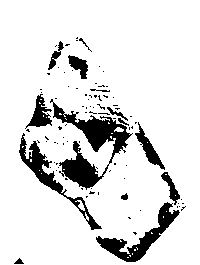The Bowdoin College Museum of Art, like most museums, sits on a trove of art and artifacts that rarely gets displayed. To give students a chance to see some of these treasures, the museum recently offered special tours to Bowdoin students, providing a rare opportunity to see museum areas normally restricted to staff members.
The storage facility, located beneath the museum and extending underground to the next-door Visual Arts Center, holds approximately 20,000 pieces of artwork in a space roughly the size of two classrooms. Roughly 1,200 of these works are paintings; the rest are prints, photographs and objects.
“It is always a lot of fun to assess the collection and spend time down here going through the artworks,” Museum Curator Joachim Homann told the 15 or so students on the tour. “We always find something new and always find fresh ways and angles to look at the art we have.”

Unknown Artist, Fragment of Glass with Figure,
200 BC-001 BC, glass, 2 3/16 in. x 1 9/16 in. (5.5 cm. x 4 cm.) Gift of Edward Perry Warren, Esq., Honorary Degree, 1926, 1915.58
The storage area is divided into two main sections: paintings to the right, and paper, object cabinets to the left. To the back are rows of Solander boxes that hold prints and photographs in a acid-free, micro-climate controlled environment.
Laura Latman, registrar and collections manager for the Museum, devised a way to organize the Museum’s many tiny objects in a series of drawers. Students on the tour leaned in close to examine some of the drawers’ contents, such as jade pieces from ancient China, statuettes from ancient Greece, and shards of precious glasses and gems.
“People say it doesn’t seem like we have 20,000 objects in our collection but that could be misleading because every little thing counts. For example, in our drawer of ancient glasses are essentially shards of glasses,” Latman said. “They add up quickly.”
In the tour, Homann also outlined the Museum’s philosophy to acquiring art for its collection. “For two hundred years, each generation of curators, directors, faculty and students responded to the question: ‘What do we want this museum to be?’ The result is an interesting, broad collection of artwork.”

Unknown Artist, Buckle,ca. 220 BC, jade/jadeite
5 1/4 in. x 2 5/8 in (13.33 cm. x 6.67 cm.) Gift of Mrs. Frederick Blackmore. 1953.23.1
Today, the Museum tries to present art that reflects the world we live in. For example, as the College attracts more students and faculty from around the world, the Museum — which was traditionally focused on Western art — now tries to bring in art from different cultures and societies, such as African American art or Asian art.
Homann also explained how the museum acquires new art. In rare occasions, the museum receives large collections, such as the Vogel donation made last semester. Usually, the process begins when it receives an offer from an alumnus, parent, foundation or donor. The museum’s team bases its decision on the piece’s condition, its value for teaching and whether its quality is on par with the rest of the museum’s collection. Whether the Museum has the space for new art is a factor, too, since its storage is limited.
“We only accept pieces that are good fits for us and would enhance our collection for a long time,” Homann said. “ We do not just accept everything.”
As students exited the tightly secured storage facility, Homann recalled the time when he brought a scholar down to storage to examine the Museum’s jade collection, and found out that a pair of jade dragons were used as belt buckles by aristocrats in 2000 BCE. “She also said that the museum she works for in China doesn’t even have jade of that quality,” Homann said. “This find and others inspired us to mount The Object Show: Discoveries at the Bowdoin College Museum of Art, on view until June 1.”

